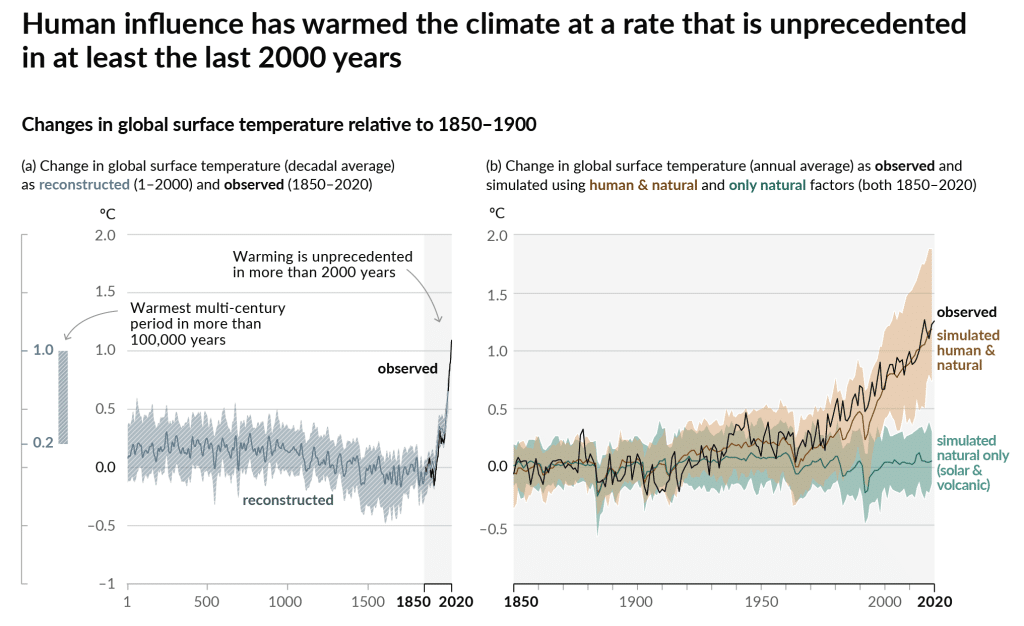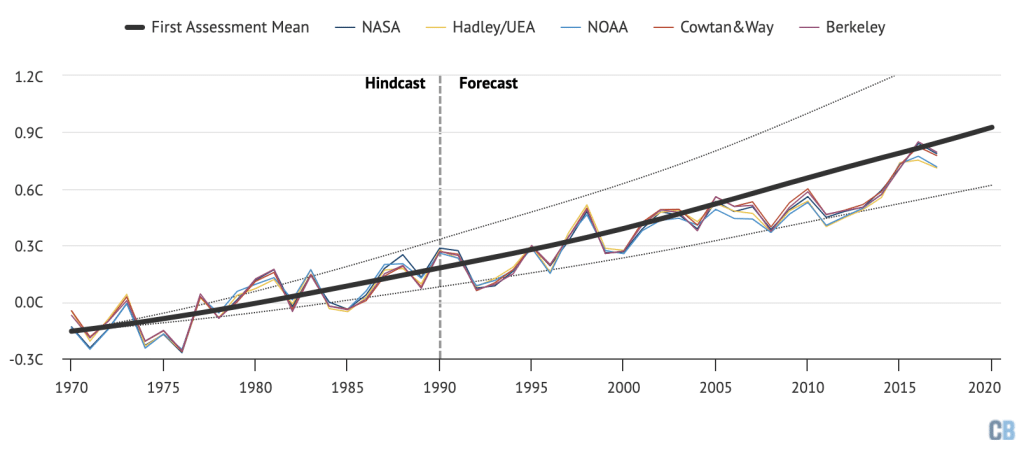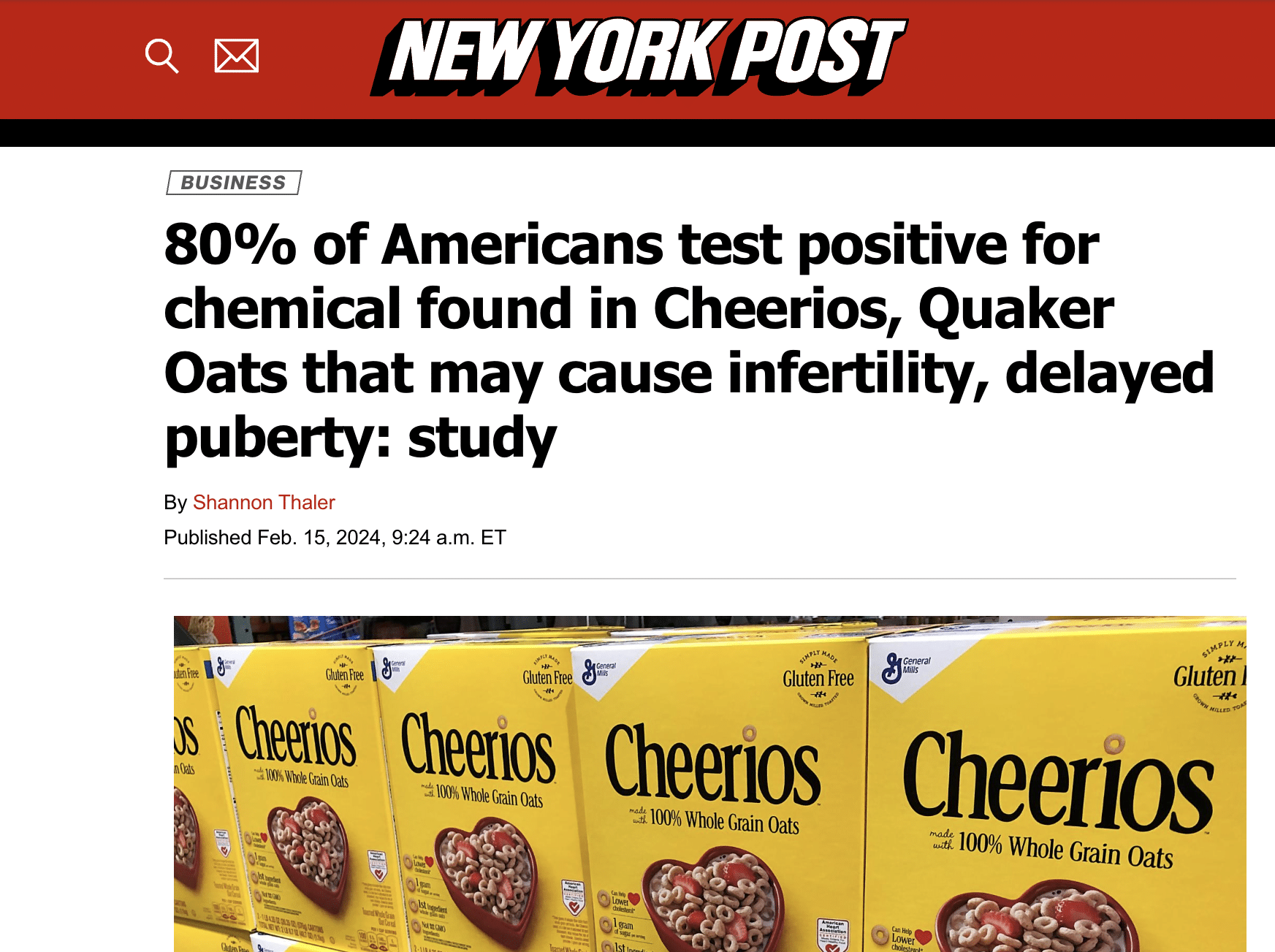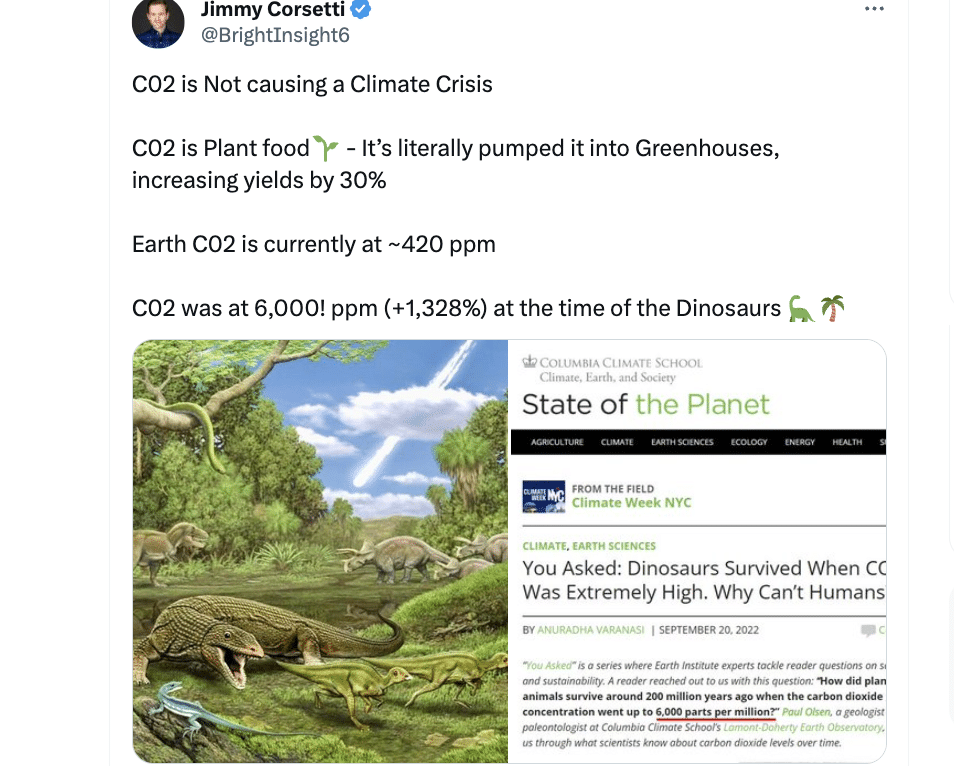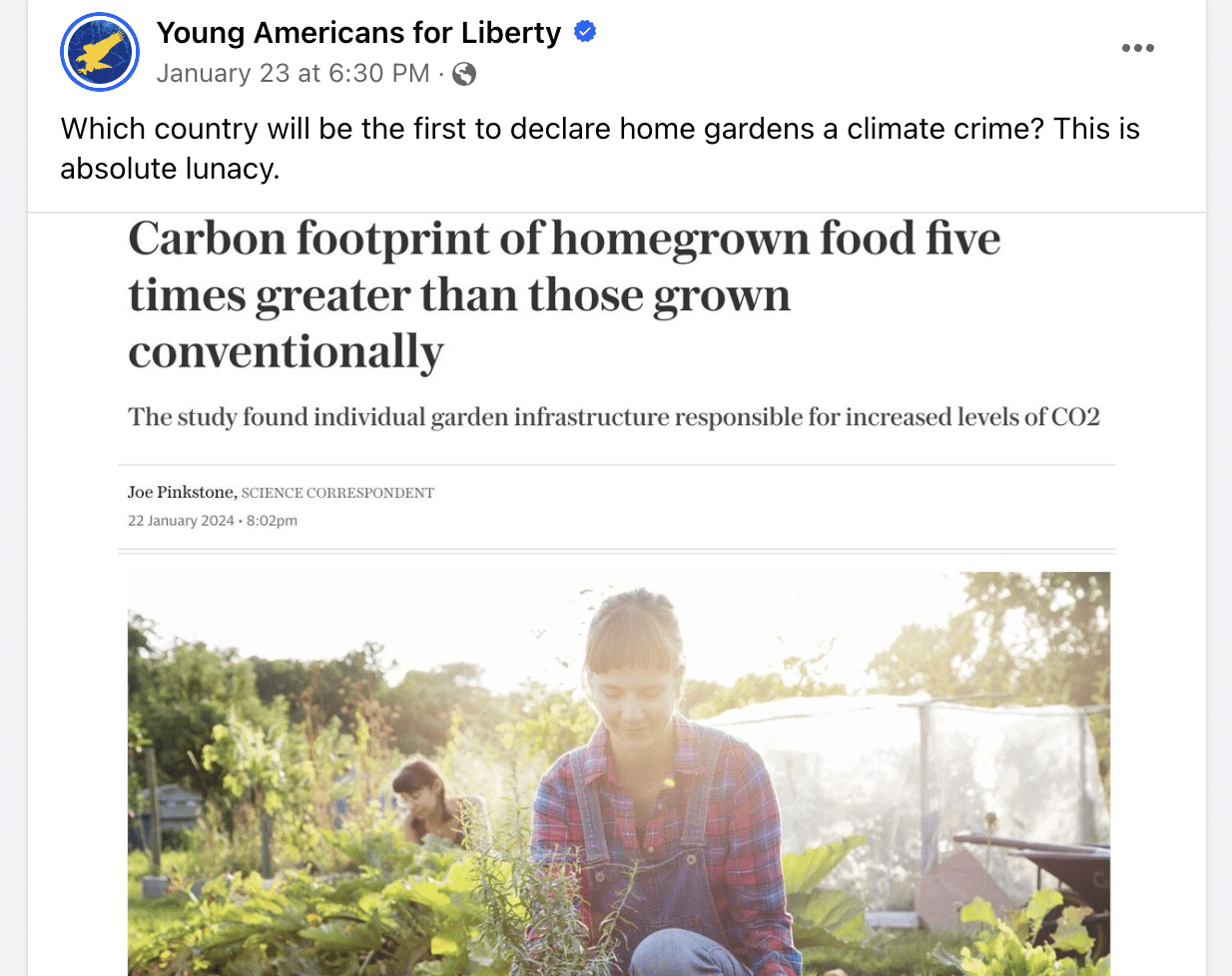- Climate
CLINTEL group inaccurately represents climate science in its declaration of “no climate emergency” once again
Key takeaway
Scientists have investigated all potential causes of climate change and concluded that human activity is responsible for modern warming, not the end of the Little Ice Age. Climate change has adverse impacts on plants and agriculture, including through its influence on extreme weather events.
Reviewed content
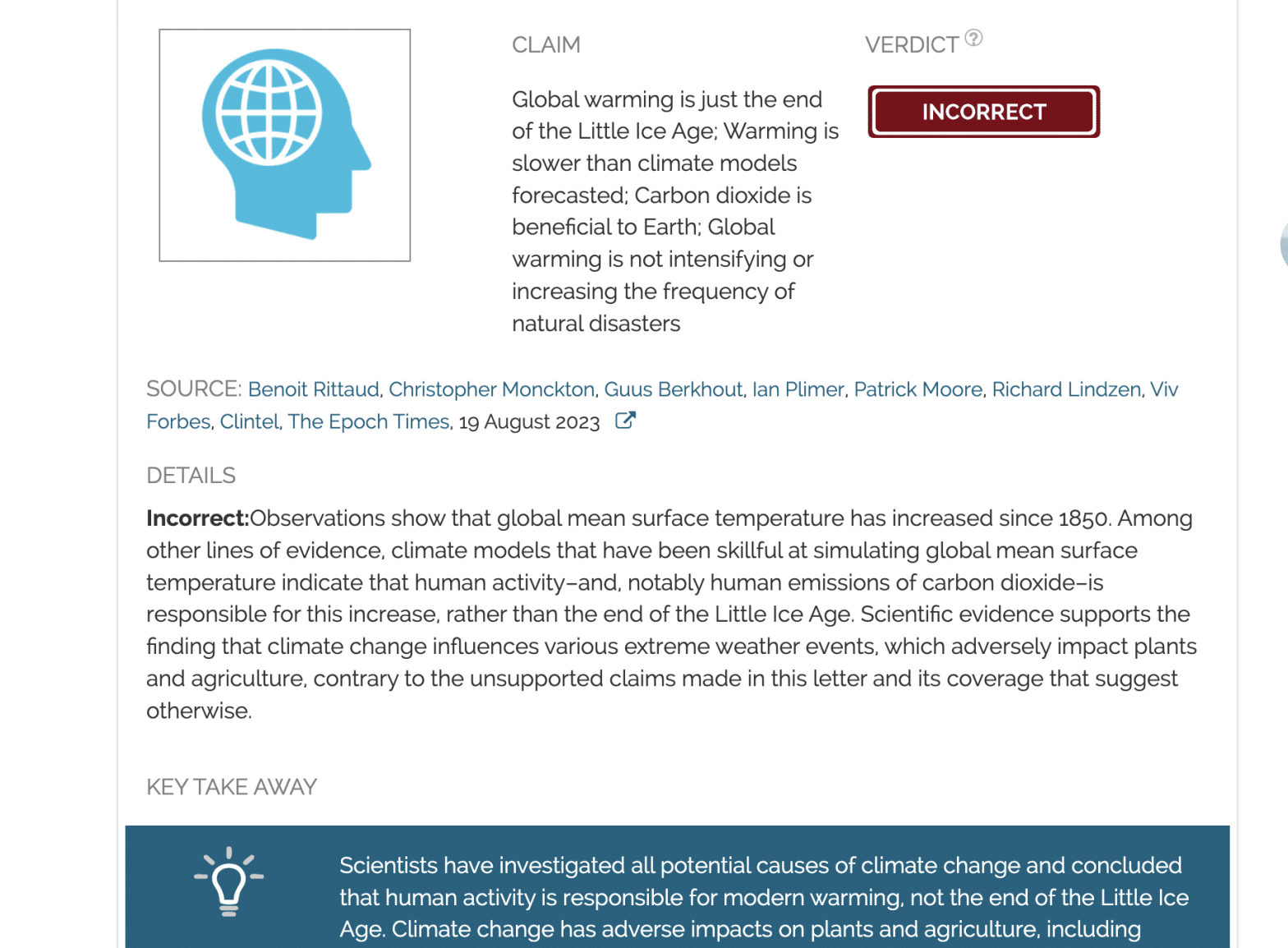
Verdict:
Claim:
Global warming is just the end of the Little Ice Age; Warming is slower than climate models forecasted; Carbon dioxide is beneficial to Earth; Global warming is not intensifying or increasing the frequency of natural disasters
Verdict detail
Incorrect:Observations show that global mean surface temperature has increased since 1850. Among other lines of evidence, climate models that have been skillful at simulating global mean surface temperature indicate that human activity–and, notably human emissions of carbon dioxide–is responsible for this increase, rather than the end of the Little Ice Age. Scientific evidence supports the finding that climate change influences various extreme weather events, which adversely impact plants and agriculture, contrary to the unsupported claims made in this letter and its coverage that suggest otherwise.
Full Claim
“The Little Ice Age ended as recently as 1850. Therefore, it is no surprise that we now are experiencing a period of warming.”; Warming is far slower than predicted”; “Climate models have many shortcomings…”; “CO2 is plant food, the basis of all life on Earth”; “There is no statistical evidence that global warming is intensifying hurricanes, floods, droughts and suchlike natural disasters, or making them more frequent.“
A letter published on August 14 by CLINTEL, a group that claims to have the support of “1,609 scientists and professionals”, repeats a series of familiar myths about climate science to arrive at its declaration that “there is no climate emergency”. The group has published similar claims about climate science in the same letter format in 2022 and 2019, both of which were previously analyzed by Climate Feedback, here and here. This year’s edition of the letter was covered by dozens of online blogs and news sites, including the Epoch Times, an outlet that has also previously published science misinformation.
The letter first claims that “it is no surprise that we are now experiencing a period of warming” because the “Little Ice Age ended as recently as 1850”. The Little Ice Age refers to a period of slight cooling, typically defined as occurring from the mid-16th to mid-19th century that was particularly strongly expressed in the northern hemisphere (Fig. 1)[1]. Scientists have proposed a variety of explanations for the cause of the Little Ice Age, including reduced solar activity[2], variations in atmospheric circulation patterns[1], changes in North Atlantic ocean circulation and ice dynamics[3], large volcanic eruptions[4], and even human-driven land-use change triggered by European colonialism[5].
Figure 1. Reconstructions and observations of global temperature change over the last two millennia. The magnitude of temperature change during the Little Ice Age, denoted by the blue-shaded region of the plot, is far outweighed by current warming. Source: Climate Lab Book
Here, the letter is implying that post-industrial warming resulted naturally from the end of this cool interval, which climate scientists say is not accurate. Climate scientists have parsed out the influence of human-caused and natural factors on global mean surface temperature, and have concluded that contemporary warming is due to human activity (Fig. 2)[6,7].
As Timothy Osborn, a climate scientist at the University of East Anglia, remarked in comments to Climate Feedback for a previous review of a similar claim, “[N]atural warming after the Little Ice Age was complete by the late 1800s. The warming from the late 1800s to the present is all due to human-caused climate change, because natural factors have changed little since then and even would have caused a slight cooling over the last 70 years rather than the warming we have observed” (Fig. 2).
Figure 2. (left) Unprecedented rate of warming since 1850 and (right) observed (black) and simulated temperature change since 1850 with (brown) and without (green) human factors. Note that natural factors alone are insufficient to explain the unprecedented post-industrial rate of warming as documented in observations. Source: IPCC AR6
The letter goes on to claim that “warming is far slower than predicted” and that “[t]he world has warmed significantly less than predicted by IPCC [the Intergovernmental Panel on Climate Change] on the basis of modeled anthropogenic forcing”. However, the results from IPCC models shown in Fig. 2 indicate that the current suite of IPCC Sixth Assessment Report (AR6) models accurately captures the observed warming since 1850. Earlier climate models have also generally been skillful at simulating global mean surface temperature (Fig. 3)[8]. While some models have overestimated warming, others have underestimated it.
As the authors of a 2019 paper[8] that explored the performance of projections by climate models over the last several decades put it, “We find no evidence that the climate models evaluated in this paper have systematically overestimated or underestimated warming over their projection period”. By suggesting that climate models have exclusively overestimated warming, the CLINTEL letter is engaging in cherry-picking–selectively reporting on only the results that match a desired outcome while excluding other pieces of relevant scientific evidence.
Figure 3. Average of model-simulated temperature change from the IPCC’s first assessment report published in 1990 (black) against various temperature observations (colors). Source: Carbon Brief
According to the letter, carbon dioxide (CO2), the greenhouse gas that is predominantly responsible for modern warming, is “plant food” that is both “favorable for nature” and “increas[es] the yield of crops worldwide”. However, scientists say that this claim oversimplifies the relationship between plants and CO2.
“The benefit[s] of increasing CO2 concentrations for plant growth are increasingly being outweighed by the negative impacts, especially of global warming”, said Sara Vicca, a plant biologist and biogeochemist at the University of Antwerp, in comments to Climate Feedback for a previous article on the topic. “This is true for natural as well as agricultural ecosystems”.
While satellite observations indicate that increasing levels of atmospheric CO2 have supported plant growth over the last few decades, these terrestrial (and marine) CO2 sinks do not remove all of the anthropogenic CO2 from the atmosphere. The uptake of carbon by terrestrial and marine plants together helps to slow the rate of warming. What’s leftover, however, causes climate change, which has a variety of adverse impacts on plants and agriculture.
According to the latest IPCC report, human influence on climate has created physical conditions likely to increase the occurrence and severity of some extreme weather events (such as heavy precipitation, compound flooding, fire weather, and agricultural and ecological drought),[6] contrary to the letter’s claim that climate change “has not increased natural disasters”. Attribution scientists have even been able to identify the influence of climate change on individual extreme weather events in some cases. For example, scientists have found that the occurrence of the 2021 heatwave in the Pacific northwest region would have been “virtually impossible” without the existence of anthropogenic climate change.[9]
These events, scientists say, put additional stress on plants and agriculture. “We are already seeing the first signs of a decline in the land CO2 sink and increasing extreme heatwaves and droughts seem to be a key reason behind this”, Vicca noted. One meta-analysis identified negative relationships between warming and the yields of maize, rice, wheat, and soy–four major agricultural crops.[10] Elevated levels of CO2 could also lower the nutritional value of rice, according to a 2016 study.[11]
The author of the Epoch Times article purports that the CLINTEL letter contains the signatories of “over 1,600 scientists”. However, as in previous iterations of this letter, this claim is misleading because many of the letter’s 1,609 signatories are non-scientists and include people with the self-reported credentials of “retired teacher and manager of a small business”, “Senior Ship Designer”, and “Financial Advice Specialist”. Additionally, very few of the signatories who identify as scientists report credentials in climate science.
References
- 1 – Mann (2002). Little Ice Age. In: Encyclopedia of Global Environmental Change
- 2 – Mauquoy et al. (2002). Evidence from northwest European bogs shows ‘Little Ice Age’ climatic changes driven by variations in solar activity. The Holocene
- 3 – Lapointe et al. (2021). Little Ice Age abruptly triggered by intrusion of Atlantic waters into the Nordic Seas. Science Advances
- 4 – Miller et al. (2012). Abrupt onset of the Little Ice Age triggered by volcanism and sustained by sea-ice/ocean feedbacks. Geophysical Research Letters
- 5 – Koch et al. (2019). Earth system impacts of the European arrival and Great Dying in the Americas after 1492. Quaternary Science Reviews
- 6 – IPCC (2023). Summary for Policymakers. In: Climate Change 2023: Synthesis Report. IPCC
- 7 – Tett et al. (2007). The impact of natural and anthropogenic forcings on climate and hydrology since 1550. Climate Dynamics
- 8 – Hausfather et al. (2020). Evaluating the performance of past climate model projections. Geophysical Research Letters
- 9 – Philip et al. (2022). Rapid attribution analysis of the extraordinary heat wave on the Pacific coast of the US and Canada in June 2021. Earth System Dynamics
- 10 – Moore et al. (2017). New science of climate change impacts on agriculture implies higher social cost of carbon. Nature Communications
- 11 – Zhu et al. (2016). Carbon dioxide (CO2) levels this century will alter the protein, micronutrients, and vitamin content of rice grains with potential health consequences for the poorest rice-dependent countries. Science Advances


